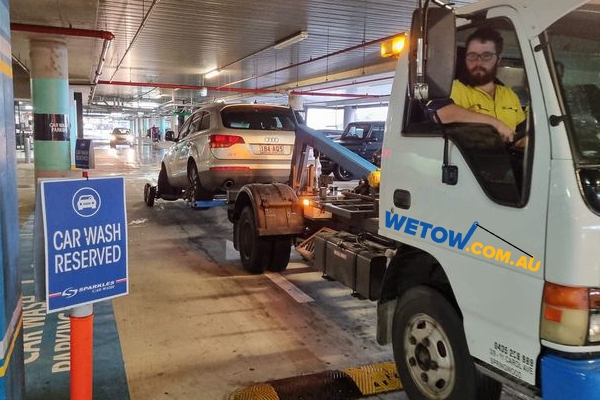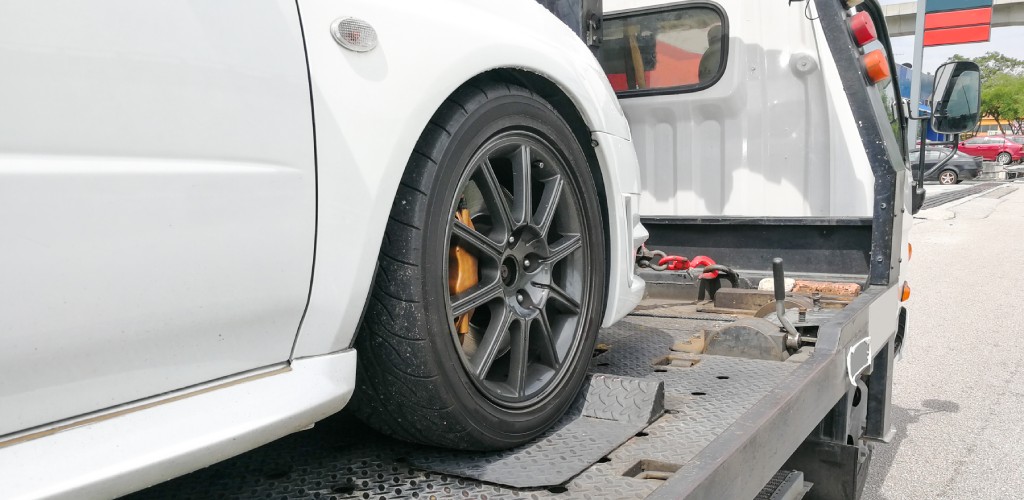Since your car is being pulled onto a tilt tray or lifted on a wheel lift, it makes sense that some people worry this could be damaging their vehicle. If you’ve been wondering the same thing, we’re going to cover everything you need to know in this article.
The simple answer: Done correctly, towing will not damage your vehicle.
The ‘done correctly’ part is important here, so let’s take a closer look at the process, important factors and potential dangers.
How your car is loaded onto a tow truck
While there are a number of different types of tow truck, there are two main categories you’ll see on the road for passenger vehicles. Those are the classic tilt tray tow truck and the wheel lift, as shown in the photos from our fleet.


Loading a tilt tray tow truck
Safely loading your car onto a tilt tray tow truck is generally straight forward. The vehicle and truck are lined up as close as practical. The tray is tilted down at an angle–hence the name tilt tray–and your car is slowly winched on.
Using a purpose built winch and specific tow points, there is virtually zero risk of damaging your vehicle in this process, provided it’s done correctly. Your car should be lined up with the tray to avoid tugging on your chassis at an angle, and only the proper tow points used.
Once on the tray, your car is then strapped down securely, the tray raised to horizontal, then double-checked again for peace of mind.
Loading a wheel lift tow truck
A wheel lift tow truck works in a completely different way, literally lifting one set of your car’s wheels off the ground.
Again, your car and the tow truck are lined up and parked close to one another, being sure to keep both vehicles parallel. Then, the lift is lowered and placed either side of the wheels and safely secured. If a dolly is required to lift the other set of wheels off the ground, this is also attached.
The hydraulic lift is then raised to the necessary height before doing a final check to make sure everything is secure. After checking that your car is in neutral and your handbrake is off, you’re ready to go.
When these jobs are carried out correctly, there’s virtually zero risk of your car getting damaged. When you’re working with a professional towing operator like WeTow, we have purpose built trucks and all the specialist equipment to reduce or remove potential hazards involved.
In addition to this, all of our staff are carefully trained to the same standard to increase safety even further. Your car has tow points engineered specifically for this task, our trucks are built for it and our drivers are well trained. Working with professionals is by far the best way to keep your vehicle safe and sound!
The risks of improper towing
While performing these towing jobs correctly is safe for your vehicle, there are some dangers involved for anyone trying to take shortcuts or use incorrect equipment. Here are just a few of the common mistakes we see people make, particularly when they’ve hired a car trailer to do the job themselves.
Using improper equipment
One of the most common mistakes we see is people using inadequate equipment to tow their vehicle from point A to point B. Often this means small car trailers being loaded with vehicles that are far too large.
We also see people trying to use ropes or thin ratchet straps from Bunnings to strap down something like a 2,750kg Patrol and drive down the highway!
We know first hand just how expensive the right equipment is, but there are some things that just aren’t worth the risk. If your 2 tonne vehicle breaks loose at 100km/h, the consequences can turn lethal in a second.
Incorrect loading
Where the vehicle is placed on a trailer is also important for everyone’s safety. When the weight is too far forward or backward on the trailer, this completely changes how your tow vehicle and trailer will handle at speed. Again, the consequences can be catastrophic if left unchecked.
Likewise, it’s important that all four wheels are safely secured in place with no room to move. Even just 2cm of slack gives your car room to build up momentum and potentially break loose under heaving braking or acceleration. For that bit of added security, your car should be in 1st gear or Park with the handbrake on, once it’s in place on the truck or trailer.
Not lining the vehicle and trailer up correctly when loading
When loading a vehicle onto a tow truck or trailer, you’re generally using just one tow point to do so. These tow points are engineered for this purpose, but are intended to pull your car a short distance in a straight line.
This minimises the amount of lateral force being applied to your chassis, making sure it stays straight and undamaged. The winch should be gently rolling your car toward the ramp, never dragging it across the ground.
While you might be tempted to just slowly winch it on from an angle, applying too much force like this will risk damaging your car.
While there’s nothing wrong with doing the job yourself, it’s important to understand the risks involved. Again, when the job is handled correctly from start to finish, there’s virtually zero risk of your car getting damaged.
Choosing the right towing service
While the towing industry has improved a lot in recent years, not all providers are created equal. So, it pays to take your time when selecting a towing operator to trust with your vehicle. There are a few basic steps you can do to help make that decision:
- Take a look at their website to gauge their level of professionalism
- Give them a call and ask questions about the job–see how they handle customer service
- Ask for a timeframe and quote before committing to the job
- Check their Google reviews for any recurring negative factors.
With these bases covered, you should be able to narrow it down pretty quickly and find a towing company that works best for you.

